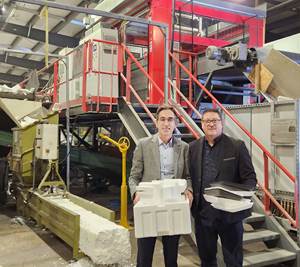Market Trends in Polymer Additive Manufacturing
Unlike the BetaMax/VHS technology debate, all the established polymer print technologies have a viable long-term role to play in the 3D-printing industry.
SmarTech Publishing has two new studies on additive manufacturing trends. The Crozet, Va.- based firm is said to be a leading provider of industry analysis and market forecasting data to the additive manufacturing industry. Here are highlights of the two reports:
● Polymer Additive Manufacturing Trends 2018: This report provides market data and analysis of market trends at the professional and industrial level. Readers will learn how the polymer 3D printing opportunity in material extrusion, photopolymerization, powder bed fusion, and jetting cuts across numerous user industries. The report covers market shipments, sales, installations, and future forecasts through 2027, providing insight into the future polymer 3D printing.
In 2018, the polymer additive manufacturing market is increasingly segmented between several leading print processes, all of which are developing into significant global technology markets for manufacturing. The company believes that a proper understanding of the opportunity in polymer 3D printing technology requires both a deep understanding of the individual nature of each widely adopted polymer print technology, but also an understanding of the interrelationship between these technologies and how those are all growing as a whole to create an industry.
Companies developing materials, software solutions, and ancillary post-processing or automation technologies for polymer 3D printers have come to understand that, unlike the great BetaMax/VHS technology debate of decades past, all of the established polymer print technologies have a viable long-term role to play in the growth of the 3D printing industry. As a result, companies such as DSM, BASF, Henkel, Siemens, Dassault Systemes, and many more continue to develop solutions for multiple print processes.
● Polymer Material Extrusion Market Poses $2.2B Revenue Opportunity
This report addresses the polymer material extrusion market, commonly known by the Stratasys trade name FDM. It is projected to generate the most revenues in polymer 3D printing hardware used in professional and industrial environments through at least 2024. By 2027, the polymer material extrusion market of non-hobbyist and consumer users will generate $2.2 billion in printer and hardware sales alone.
In 2017, material extrusion 3D printing technology generated the greatest amount of revenues for 3D printers—more than other polymer printing processes such as powder bed fusion and vat photopolymerization. About 70% of those revenues was associated with low-cost desktop and consumer extrusion printers. This segment features printers ranging from lower-end Stratasys products like the Mojo, uPrint, and F170, to the entire product range of companies like Ultimaker, Aleph, Objects, Leapfrog, Zortrax and many more.
From a competitive standpoint, material extrusion 3D printing technology is mostly controlled by a single company—Stratasys. However, the dynamics of the market have continued to change significantly over the last several years. Not only have new entrants become more established with business models in selling printing solutions exclusively to professional users (such as Cincinnati, Inc.), but perhaps more notable has been the number of companies that has transitioned from marketing low-cost printers primarily to consumers and educational customers to making systems for more manufacturing and business-oriented use.
These companies have indeed eroded Stratasys’ overall market share in the polymer material extrusion market in professional environments over the last several years. For example, in the first quarter 2018, multinational manufacturer Bosch made an investment in Dutch provider Ultimaker, which will become a worldwide supplier to Bosch with extrusion-based printing solutions. Just five years ago, it would be relatively unheard of for a multinational company of that size to engage at such a broad levels with any other extrusion 3D printing solution provides than Stratasys.
Related Content
Infrastructure May Prove Big Landing Spot for Recycled Plastics
As the government funds infrastructure improvements, a hot topic at NPE2024 – exploration of the role recycled plastics can play in upcoming projects, particularly road development.
Read MoreNova Makes Senior Leadership Changes
The company’s aim is to bolster sustainability ambitions
Read MoreNexkemia Acquires Polystyrene Recycling Assets
The polystyrene manufacturer finalized its purchase of Eco-Captation, a recycler.
Read MoreIneos Nitriles Launches Biobased Acrylonitrile
The company’s Invireo is said to deliver a 90% lower carbon footprint compared to conventionally produced acrylonitrile.
Read MoreRead Next
Understanding Melting in Single-Screw Extruders
You can better visualize the melting process by “flipping” the observation point so that the barrel appears to be turning clockwise around a stationary screw.
Read MoreProcessor Turns to AI to Help Keep Machines Humming
At captive processor McConkey, a new generation of artificial intelligence models, highlighted by ChatGPT, is helping it wade through the shortage of skilled labor and keep its production lines churning out good parts.
Read MoreAdvanced Recycling: Beyond Pyrolysis
Consumer-product brand owners increasingly see advanced chemical recycling as a necessary complement to mechanical recycling if they are to meet ambitious goals for a circular economy in the next decade. Dozens of technology providers are developing new technologies to overcome the limitations of existing pyrolysis methods and to commercialize various alternative approaches to chemical recycling of plastics.
Read More


























